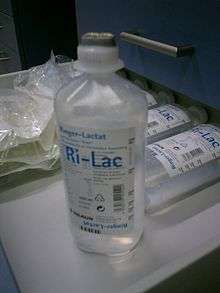Lactated Ringer's solution

Ringer's lactate solution, also known as Ringer-Locke's solution or simply Ringer-lactate, is a solution that is isotonic with blood. It is intended for intravenous administration in humans, but in veterinary use may also be given subcutaneously. Ringer's lactate solution is grouped with intravenous fluids known as "crystalloids", which include saline and dextrose solutions (compared to the "colloids" which contain larger molecules such as starch or gelatine).
Ringer's lactate solution is abbreviated as "LR", "RL" or "LRS". It is also known as lactated Ringer's solution (although Ringer's solution technically refers only to the saline component, without lactate). It is very similar, though not identical, to Hartmann's solution, which is more commonly found in British and Irish hospitals and has slightly different ionic concentrations.
Some countries instead use a Ringer's acetate solution or Ringer-acetate, which has similar properties and the added benefit of not deranging the blood-lactate level. This may be helpful when analyzing blood-lactate for signs of anaerobic metabolism (e.g. present with infection or lactic acidosis which may be caused by excessive metformin-intake).
Medical uses
Ringer's lactate solution is very often used for fluid resuscitation after a blood loss due to trauma, surgery, or a burn injury. Ringer's lactate solution is used because the by-products of lactate metabolism in the liver counteract acidosis, which is a chemical imbalance that occurs with acute fluid loss or renal failure.[1]
The IV dose of Ringer's lactate solution is usually calculated by estimated fluid loss and presumed fluid deficit. For fluid resuscitation the usual rate of administration is 20 to 30 ml/kg body weight/hour. LR is not suitable for maintenance therapy (i.e., maintenance fluids) because the sodium content (130 mEq/L) is considered too low, particularly for children, and the potassium content (4 mEq/L) is too low, in view of electrolyte daily requirement. Moreover, since the lactate is converted into bicarbonate, longterm use will cause patients to become alkalotic.[2] Ringer's lactate and other crystalloids are also used as vehicles for the IV delivery of drugs.
In a large-volume resuscitation over several hours, LRS maintains a more stable blood pH as compared to normal saline.[3]
Chemistry
One liter of Ringer's lactate solution contains:
- 130 mEq of sodium ion = 130 mmol/L
- 109 mEq of chloride ion = 109 mmol/L
- 28 mEq of lactate = 28 mmol/L
- 4 mEq of potassium ion = 4 mmol/L
- 3 mEq of calcium ion = 1.5 mmol/L
Ringer's lactate has an osmolarity of 273 mOsm/L.[4] The lactate is metabolized into bicarbonate by the liver, which can help correct metabolic acidosis. Ringer's lactate solution alkalinizes via its consumption in the citric acid cycle, the generation of a molecule of carbon dioxide which is then excreted by the lungs. They increase the strong ion difference in solution, leading to proton consumption and an overall alkalinizing effect.[5]
The solution is formulated to have concentrations of potassium and calcium that are similar to the ionized concentrations found in normal blood plasma. To maintain electrical neutrality, the solution has a lower level of sodium than that found in blood plasma or normal saline.[3]
Generally, the sodium, chloride, potassium and lactate come from NaCl (sodium chloride), NaC3H5O3 (sodium lactate), CaCl2 (calcium chloride), and KCl (potassium chloride).
There are slight variations for the composition for Ringer's as supplied by different manufacturers. As such, the term Ringer's lactate should not be equated with one precise formulation.[6]
Although its pH is 6.5, it is an alkalizing solution.
History
Ringer's saline solution was invented in the early 1880s by Sydney Ringer,[3] a British physician and physiologist. Ringer was studying the beating of an isolated frog heart outside of the body. He hoped to identify the substances in blood that would allow the isolated heart to beat normally for a time.[7] The use of Ringer's original solution of inorganic salts slowly became more popular.[3] In the 1930s, the original solution was further modified by American pediatrician Alexis Hartmann for the purpose of treating acidosis. Hartmann added lactate, which mitigates changes in pH by acting as a buffer for acid. Thus the solution became known as "Ringer's lactate solution" or "Hartmann's solution".[3][8]
Veterinary use
It is used for the treatment or palliative care of chronic renal failure in small animals. The solution can be administered both by IV and subcutaneously. Administering the fluids subcutaneously allows the solution to be readily given to the animal by a trained layperson, as it is not required that a vein be located. The solution is slowly absorbed from beneath the skin into the bloodstream of the animal.
See also
- Hartmann's solution
- Intravenous therapy
- Oral rehydration therapy
- Phosphate buffered saline (cell culture)
- Saline (medicine)
- Tyrode's solution
References
- ↑ Lactated Ringer's package insert information, side effects and uses
- ↑ "LACTATED RINGERS (sodium chloride, sodium lactate, potassium chloride, and calcium chloride) injection, solution [B. Braun Medical Inc.]". HUMAN PRESCRIPTION DRUG LABEL. DailyMed.
ADVERSE REACTIONS [...] although the metabolism of lactate to bicarbonate is a relatively slow process, aggressive administration of sodium lactate may result in metabolic alkalosis. Careful monitoring of blood acid-base balance is essential during the administration of sodium lactate.
- 1 2 3 4 5 Kenneth M Sutin; Marino, Paul L. (2007). The ICU book. Hagerstwon, MD: Lippincott Williams & Wilkins. ISBN 0-7817-4802-X.
- ↑ Williams EL, Hildebrand KL, McCormick SA, Bedel MJ (May 1999). "The effect of intravenous lactated Ringer's solution versus 0.9% sodium chloride solution on serum osmolality in human volunteers" (PDF). Anesth. Analg. 88 (5): 999–1003. doi:10.1213/00000539-199905000-00006. PMID 10320158.
- ↑ Acid-base abnormalities in the intensive care unit.
- ↑ DailyMed Result
- ↑ Miller, DJ (2004). "Sydney Ringer; physiological saline, calcium and the contraction of the heart". The Journal of Physiology. 555 (Pt 3): 585–7. doi:10.1113/jphysiol.2004.060731. PMC 1664856
 . PMID 14742734.
. PMID 14742734. - ↑ White SA, Goldhill DR (May 1997). "Is Hartmann's the solution?". Anaesthesia. 52 (5): 422–7. doi:10.1111/j.1365-2044.1997.090-az0082.x. PMID 9165959.